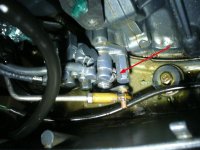First time trying to bleed air from a 2-stroke oil injection pump on a Yamaha 40hp (3 cylinder).
The oil reservoir is inside the cowling. I'm puzzled by there being two oil lines between this reservoir and the oil injection pump.
Photo of the reservoir attached below. Also a rough diagram to show the two oil lines.
In the diagram, line B is the main feed of oil from the bottom of the reservoir to the oil pump at F.
But there is also line A from the reservoir to the top of the oil pump with a check valve allowing flow only towards E.
Appreciate anyone able to explain why and when oil will flow through this second line?
The oil reservoir is inside the cowling. I'm puzzled by there being two oil lines between this reservoir and the oil injection pump.
Photo of the reservoir attached below. Also a rough diagram to show the two oil lines.
In the diagram, line B is the main feed of oil from the bottom of the reservoir to the oil pump at F.
But there is also line A from the reservoir to the top of the oil pump with a check valve allowing flow only towards E.
Appreciate anyone able to explain why and when oil will flow through this second line?




